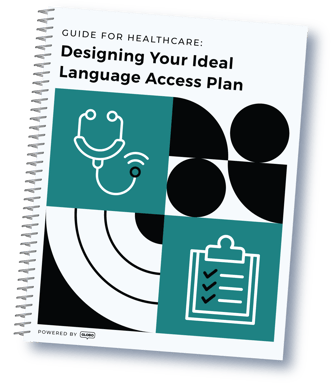Stay up to date.
Stay connected with tips, resources & stories on language access.
Outcome-based care is transforming the healthcare industry. As providers transition to patient centricity — an approach that encourages patients to take a more active role — they’re seeing a dramatic decrease in costs and readmission rates. But what happens when those messages of empowerment get lost?
The benefits of a patient-centric approach disappear when communication barriers persist. For limited-English proficient (LEP) patients, miscommunication and unavailability of qualified medical interpreters have been linked to serious adverse events, contributing to disparities in patient safety between English-speaking and LEP patients. A well-designed Language Access Plan can help health systems combat these disparities, enabling them to better serve the LEP population while improving provider experience and lowering overall costs.
A Language Access Plan (LAP) is a strategic effort to eliminate or reduce limited English proficiency as a barrier to accessing information. Most Language Access Plans can be built on a structure that includes the following sections, then customized to best serve your facility:
Any organization that serves a population with limited-English proficiency should have a Language Access Plan. In health systems, Section 1557 of the Affordable Care Act requires that entities that receive federal assistance must provide a comprehensive Language Access Plan for LEP patients. If your facility receives federal funds or is accredited by entities such as the Joint Commission, you should have a Language Access Plan in place.
With recent changes to the healthcare industry, including the increase in telehealth visits and new legislation such as the No Surprises Act, providers should include these new considerations in their Language Access Plan to ensure all patients have equal access to care, no matter what language they speak.
Before getting started, your organization should define the goals for the Language Access Program as a whole, and define a purpose and policy that will provide transparency, visibility, and understanding across your organization. Next, designate a Language Access Coordinator — depending on the size of your facility, this might be an individual or a committee that oversees various aspects of the Language Access Plan. Once your Language Access Team has been defined, they can begin to design the plan.
Determine the needs of current and prospective patients, such as preferred languages, how those patients interact with the organization, and which departments the patient may come into contact with (call center, reception, intake staff, etc.). Begin to build out the structure of your plan and identify the resources needed to implement, such as key stakeholders, budget, and staff requirements. You should also conduct research to determine legal and accreditation requirements that align with federal, state, and local laws.
Designing a Language Access Plan will require support and resources, so gaining approval for your plan from executive stakeholders will help promote compliance within the organization and benefit the overall development of the plan. Staff members across the organization must work together to provide the best possible experience for everyone, no matter what language the patient speaks.
At this point, you're ready to designate key roles and accompanying responsibilities. Who will be the main point of contact for your language service provider? Who will track the budget, compliance, and program feedback? Defining the core team for your LAP and preparing for what lies ahead will set your organization up for language access success.
The next step is to find a language services provider that allows access to qualified medical linguists via telephone interpreting, video remote interpreting, and on-site interpreting, as well as document and on-demand text translation. A language services provider should also offer insights into population data, which provides visibility into your health system’s limited-English-speaking population. Armed with this knowledge, you can be better prepared to care for limited-English patients by translating critical documents (such as consent forms) in advance, or by hiring in-house interpreters for the most commonly spoken languages spoken in your area.
 Formalize, Distribute, & Implement
Formalize, Distribute, & ImplementNow that you’ve laid out the foundation for your LAP, it’s time to formalize it into a distributable piece of information. Format a clear, concise document that can be shared within your organization. Set aside time to train and educate staff on your new or updated LAP to ensure organization-wide compliance. Arm staff with the resources they’ll need to implement and adhere to the LAP, including information on who they should reach out to should any questions arise.
 Looking for more guidance on how to design your Language Access Plan?
Looking for more guidance on how to design your Language Access Plan?Since launching the original Language Access Plan workbook in 2020, the healthcare industry has faced new changes and challenges.
Download our recently updated step-by-step workbook, Designing Your Ideal Language Access Plan, to build your personalized plan and access additional tips and resources to guide you on your journey.
Last Updated: 5/24/2022